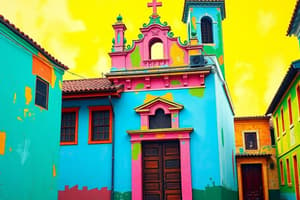Podcast
Questions and Answers
What are the materials used to build a typical 'bahay kubo'?
What are the materials used to build a typical 'bahay kubo'?
- Nipa Palm (correct)
- Bamboo (correct)
- Plastic
- Wood (correct)
Who led the government during the Pre-Spanish period?
Who led the government during the Pre-Spanish period?
Datu
Which god is known as the God of Agriculture in the native beliefs?
Which god is known as the God of Agriculture in the native beliefs?
- Sidapa
- Bathala
- Idiyanale (correct)
- Agni
Lapu-Lapu is regarded as the first national hero of the Philippines.
Lapu-Lapu is regarded as the first national hero of the Philippines.
The three reasons for Spanish colonization can be summarized as ___, Gold, and Glory.
The three reasons for Spanish colonization can be summarized as ___, Gold, and Glory.
What was established by Miguel López de Legazpi in 1565?
What was established by Miguel López de Legazpi in 1565?
What is the Spanish influence on Philippine law called?
What is the Spanish influence on Philippine law called?
Match the following native gods with their respective domains:
Match the following native gods with their respective domains:
What is a common practice in Philippine customs influenced by the Spanish?
What is a common practice in Philippine customs influenced by the Spanish?
Flashcards are hidden until you start studying
Study Notes
Pre-Spanish Period
Houses
- Traditional houses called bahay kubo, constructed from wood, bamboo, and nipa palm.
- Ethnic groups like Kalingas, Mandayas, and Bagobos often built their houses on treetops.
- The Badjaos constructed their homes on boats, reflecting adaptability to their environment.
Mode of Dressing/Clothing
- Male Clothing:
- Kanggan: Sleeveless jacket, red for chiefs and black/blue for commoners.
- Bahag: Traditional loincloth.
- Putong: Turban indicating social status and achievements.
- Female Clothing:
- Baro/Camisa: Jacket with sleeves.
- Saya/Patadyong: A long skirt.
- Tapis: Piece of cloth worn atop the skirt, usually red or white.
Government
- Leadership was held by a Datu, the chieftain.
- Barangay derived from Balangay, a Malay term meaning "boat."
- The Datu's responsibilities included leadership in war, community activities like planting and harvesting, and collecting taxes (buwis).
Sanduguan or Blood Compact
- Served as a method of establishing friendship and alliances among leaders.
- Formalized agreements between parties.
Judicial Process
- Utilized trial by ordeal as a means of justice.
Religious Beliefs and Practices
- Worshipped deities such as:
- Bathala: The supreme being.
- Idiyanale: God of agriculture.
- Sidapa: God of death.
- Agni: God of fire.
- Balangaw: God of the rainbow.
- Lalahon: God of harvest.
- Siginarugan: God of hell.
Superstitious Beliefs
- Beliefs in various creatures:
- Aswang: Witch.
- Dwende: Tiny creatures similar to humans.
- Kapre: Large, apelike beings known for smoking, typically found in trees.
- Mangkukulam: An old woman capable of inflicting harm using a pin and a doll.
- Tikbalang: Half man, half horse creature.
- Tiyanak: Mythical baby that sucks blood.
Spanish Colonization (1521 - 1898)
Lapu-Lapu
- Ruler of Mactan, known for resisting Spanish colonization.
- Defeated Magellan's forces on April 27, 1521, marking a significant event in Philippine history.
- Recognized as the first national hero of the Philippines.
Spanish Settlement
- After unsuccessful expeditions, Miguel López de Legazpi established the Philippines' first permanent Spanish settlement in Cebu in 1565.
- Manila founded in 1571; by the end of the 16th century, much of the archipelago was under Spanish control.
- Missionaries converted many locals to Roman Catholicism.
Reasons for Colonization (3 G's)
- God: Spread of Christianity.
- Gold: Economic exploitation and resource acquisition.
- Glory: National prestige and expansion.
Spanish Influence in Contemporary Culture
-
Law: Introduction of the cedula system.
-
Religion: Dominance of Christianity.
-
Education: Religion-oriented educational systems.
-
Language: Influence on Tagalog and Bisaya.
-
Family Names: Adoption of names like Legazpi.
-
Architecture: Spanish-style churches, such as San Agustin Church.
-
Arts: Strong religious iconography.
-
Music: Traditional songs like harana and kundiman, used in courtship.
-
Cuisine: Incorporation of ingredients such as avocado, coffee, and corn into local dishes.
-
Customs: Social practices like cheek kissing and communal gatherings, emphasizing familial and community ties.
-
Spanish influences have blended into the modern-day Philippine culture.
Studying That Suits You
Use AI to generate personalized quizzes and flashcards to suit your learning preferences.




